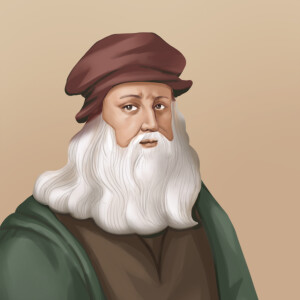Episodes

Friday Aug 18, 2023
Friday Aug 18, 2023
Chapter 1:Deep Work Author
Cal Newport is the author of the book "Deep Work: Rules for Focused Success in a Distracted World." He is a computer science professor at Georgetown University and has gained recognition for his research and writings on productivity, career development, and digital minimalism.
Newport holds a Ph.D. from MIT and has published several books that explore topics related to studying, working, and thriving in the modern information age. "Deep Work," published in 2016, quickly became a bestseller and garnered widespread acclaim for its insights into combating distractions and enhancing focus.
In "Deep Work," Newport argues that in today's technology-driven world, the ability to concentrate without distraction on cognitively demanding tasks is becoming increasingly rare and valuable. He presents strategies and principles to help individuals achieve a state of deep work, which he defines as the ability to focus without interruption on high-value work that produces meaningful results.
Newport draws upon a range of disciplines, including psychology, neuroscience, and behavioral economics, to support his arguments and provide practical advice for cultivating deep work habits. He emphasizes the importance of eliminating distractions, creating structured routines, and practicing deliberate practice to maximize productivity and creativity.
As an author and speaker, Cal Newport has become known for his evidence-based and pragmatic approach to productivity, offering valuable insights and actionable strategies for individuals seeking to optimize their professional and personal lives in an increasingly distracted world.
Chapter 2:What is the Deep Work about
"Deep Work: Rules for Focused Success in a Distracted World" by Cal Newport is a book that explores the concept of deep work and its importance in achieving high levels of productivity, creativity, and success in a world filled with distractions.
The book argues that in today's digital age, constant connectivity and the prevalence of shallow work (such as email, social media, and multitasking) have eroded our ability to focus deeply on meaningful and valuable tasks. Newport defines deep work as the ability to concentrate without distraction on cognitively demanding activities, producing higher-quality results in less time.
Newport presents several strategies and practical techniques to cultivate deep work habits. These include eliminating or minimizing distractions, setting clear boundaries, creating structured routines, and adopting deliberate practice to improve skills and achieve mastery.
Throughout the book, Newport emphasizes the tremendous benefits of deep work, such as enhanced productivity, improved cognitive abilities, increased creativity, and a sense of fulfillment. He also addresses common challenges and misconceptions surrounding deep work, providing guidance on how to integrate it into different professions and lifestyles.
By embracing deep work, individuals can harness their full cognitive potential and produce superior work, leading to greater professional success and personal satisfaction. "Deep Work" serves as a guide for navigating the modern work environment and reclaiming our ability to focus deeply on what truly matters.
Chapter 3:Books Similar to Deep Work
"Digital Minimalism: Choosing a Focused Life in a Noisy World" by Cal Newport: In this book, Newport explores the concept of digital minimalism and provides practical strategies to break free from the constant pull of technology and cultivate a more intentional and focused digital life.
"Essentialism: The Disciplined Pursuit of Less" by Greg McKeown: This book delves into the idea of essentialism, guiding readers to identify what truly matters and eliminate non-essential tasks and commitments. It offers insights on how to focus on the vital few and reduce the distractions that hinder productivity.
"The 4-Hour Workweek: Escape 9-5, Live Anywhere, and Join the New Rich" by Timothy Ferriss: Ferriss challenges traditional notions of work and productivity, offering unconventional approaches to achieve more with less effort. He shares strategies on automating and outsourcing tasks, managing time effectively, and designing a lifestyle with more freedom and purpose.
"Peak Performance: Elevate Your Game, Avoid Burnout, and Thrive with the New Science of Success" by Brad Stulberg and Steve Magness: This book explores the science behind peak performance, providing insights on how to optimize productivity, manage stress, and develop sustainable habits to excel in various domains of life.
"Smarter Faster Better: The Secrets of Being Productive in Life and Business" by Charles Duhigg: Duhigg investigates the science of productivity and offers actionable strategies based on behavioral psychology. He explores topics such as goal setting, motivation, decision-making, and teamwork to help readers become more efficient and effective.

Friday Aug 18, 2023
Friday Aug 18, 2023
Chapter 1:When The Power of Now Take Place
"The Power of Now" by Eckhart Tolle does not take place in a specific time or setting. It is a spiritual and philosophical guide that explores the concept of living in the present moment and finding inner peace and enlightenment. The principles and teachings presented in the book are timeless and applicable to individuals in any time period, offering insights into the nature of consciousness, ego, and the human experience.
Chapter 2:Theme of The Power of Now
The main theme of "The Power of Now" by Eckhart Tolle is the importance of living in the present moment and finding inner peace. The book explores the concept of the ego and how it creates suffering, anxiety, and discontent in our lives. Tolle argues that true happiness and fulfillment can only be found by transcending the constant chatter of the mind and fully embracing the present moment.
Another key theme is the idea of identifying with our consciousness or inner being rather than our thoughts, emotions, and external circumstances. Tolle encourages readers to observe their thoughts without judgment and detach from the constant stream of mental activity. By doing so, individuals can tap into a deeper level of awareness and discover a sense of stillness and tranquility that lies beyond the mind.
The book also emphasizes the interconnectedness of all beings and the importance of compassion and acceptance. Tolle suggests that by embracing the present moment and accepting things as they are, we can cultivate healthier relationships, achieve inner harmony, and experience a greater sense of joy and fulfillment.
Overall, the theme of "The Power of Now" revolves around transcending the limitations of the thinking mind, embracing the present moment, and accessing a state of consciousness that is free from suffering and in alignment with the inherent peace and wisdom that resides within us.
Chapter 3:Recources of The Power of Now
Guided Meditations: Tolle has released several guided meditation recordings that complement the teachings in "The Power of Now." These meditations can help individuals cultivate mindfulness and presence in their daily lives.
Online Talks and Interviews: Eckhart Tolle has participated in various talks, interviews, and seminars where he expands on the concepts explored in his book. Many of these videos are available online, allowing viewers to deepen their understanding and gain additional insights.
Workbooks and Study Guides: Some readers may find it helpful to engage with workbooks or study guides specifically designed to accompany "The Power of Now." These resources often provide reflective exercises, journaling prompts, and practical applications to enhance the learning experience.
Discussion Groups and Online Communities: Joining or forming a discussion group or participating in online communities focused on "The Power of Now" can be beneficial for sharing insights, asking questions, and engaging in meaningful conversations with others who are exploring similar concepts.
Retreats and Workshops: Eckhart Tolle occasionally hosts retreats, workshops, and live events where participants have the opportunity to delve deeper into the teachings of "The Power of Now" through guided practices, discussions, and interactions with other like-minded individuals.
Additional Books by Eckhart Tolle: Tolle has written other books that expand upon the ideas presented in "The Power of Now." Titles such as "A New Earth" and "Stillness Speaks" offer further insights into spirituality, consciousness, and personal transformation.

Friday Aug 18, 2023
Friday Aug 18, 2023
Chapter 1:What is Man's Search for Meaning about
"Man's Search for Meaning" by Viktor E. Frankl is a memoir and psychological exploration of the author's experiences as a Holocaust survivor and his development of logotherapy, a form of psychotherapy focused on finding meaning in life.
The book is divided into two parts. In the first part, Frankl recounts his time spent in Nazi concentration camps during World War II, where he endured extreme suffering and witnessed the horrors of the Holocaust. Through his observations and personal reflections, he delves into the psychological struggles faced by prisoners, including feelings of hopelessness, loss of identity, and the constant threat of death. Despite these circumstances, Frankl emphasizes that individuals have the freedom to choose their attitudes and find meaning even in the most challenging situations.
In the second part of the book, Frankl elaborates on the concept of logotherapy, which focuses on helping individuals discover purpose and significance in their lives. He argues that finding meaning is a fundamental human need and can be achieved through three main avenues: creating meaningful work or activities, experiencing love and relationships, and adopting an attitude of resilience and acceptance toward unavoidable suffering.
Frankl draws on his own experiences and the insights gained from his time in the concentration camps to provide a profound perspective on the human search for meaning. His work emphasizes the importance of personal responsibility, finding purpose in life, and the power of mindset in dealing with adversity.
"Man's Search for Meaning" has resonated with millions of readers worldwide, offering a deeply moving account of survival in the face of unspeakable hardships and providing a thought-provoking exploration of existential questions and the pursuit of meaning in one's life.
Chapter 2:Man's Search for Meaning Characters
"Man's Search for Meaning" by Viktor E. Frankl primarily focuses on the author's personal experiences and reflections during his time in Nazi concentration camps rather than specific characters. However, there are a few notable individuals mentioned in the book:
Viktor E. Frankl: The author and protagonist of the memoir. Frankl was an Austrian psychiatrist and Holocaust survivor who developed logotherapy, a form of psychotherapy that emphasizes finding meaning in life.
Other Prisoners: Throughout the narrative, Frankl encounters and interacts with various fellow prisoners in the concentration camps. These individuals come from diverse backgrounds and play a role in illustrating the varying responses to extreme suffering and the search for meaning amidst unimaginable circumstances.
Guards and Officials: The book also briefly mentions the guards and officials at the concentration camps who enforced the brutal conditions and dehumanization of the prisoners. They represent the oppressive forces that the prisoners had to contend with during their time in the camps.
It is important to note that "Man's Search for Meaning" primarily focuses on Frankl's own experiences and philosophical insights rather than extensive character development. The book revolves around the author's inner journey, reflections on humanity, and the search for meaning in the midst of immense suffering.
Chapter 3:Man's Search for Meaning Chapters
Part One: Experiences in a Concentration Camp
Experiences in a Concentration Camp: This chapter sets the stage by providing an overview of Frankl's time in Nazi concentration camps during World War II and introduces the themes of suffering, survival, and the search for meaning.
Logotherapy in a Nutshell: Frankl introduces logotherapy, his psychotherapeutic approach that focuses on helping individuals find meaning in life even amidst intense suffering. He outlines the basic principles and concepts behind logotherapy.
The Case for Tragic Optimism: This chapter explores how individuals can maintain a sense of optimism and hope even in the face of extreme adversity. Frankl discusses the concept of "tragic optimism" as a way to find meaning and purpose in difficult circumstances.
Freedom and Responsibility: Frankl examines the idea of freedom and personal responsibility, emphasizing that individuals have the power to choose their attitudes and responses to any given situation.
The Mental Health Triad: This chapter delves into the three main sources of meaning that contribute to mental health: work or achievements, relationships and love, and the attitude one adopts toward unavoidable suffering.
Part Two: Logotherapy in a Nutshell
The Meaning of Life: Frankl reflects on the search for ultimate meaning in life and suggests that it is an individual journey unique to each person. He explores the quest for transcendence and spirituality.
Psychotherapy and Existentialism: In this chapter, Frankl discusses the relationship between logotherapy and existentialism, highlighting the differences and similarities between the two schools of thought.
The Will to Meaning: Frankl explores the fundamental human need for meaning and purpose, discussing the importance of having a sense of purpose as a driving force for mental well-being.
Logotherapy in a Nutshell: This chapter provides a concise summary of logotherapy, outlining its main principles and therapeutic techniques.
The Case Against Suicide: Frankl presents arguments against suicide, emphasizing that even in the most desperate circumstances, life can hold meaning and individuals can find reasons to continue living.
Postscript: The book concludes with a postscript where Frankl reflects on the significance of his experiences and imparts his final thoughts on the search for meaning and the human spirit.

Friday Aug 18, 2023
Friday Aug 18, 2023
Chapter 1:12 Rules for Life Author
Jordan B. Peterson is a Canadian psychologist, professor, and author known for his book "12 Rules for Life: An Antidote to Chaos." Born in 1962, Peterson has gained significant attention for his insights on psychology, philosophy, and social issues.
Peterson is a professor of psychology at the University of Toronto. He has taught and conducted research in areas such as personality psychology, social psychology, and clinical psychology. Throughout his academic career, he has published numerous scientific papers and delivered lectures on topics related to psychology and human behavior.
However, it was his book "12 Rules for Life" that brought him widespread recognition and international acclaim. Published in 2018, the book presents a collection of philosophical and practical rules designed to help individuals navigate the complexities of modern life and find meaning and fulfillment. Drawing from various disciplines such as psychology, mythology, literature, and religion, Peterson combines personal anecdotes and thought-provoking insights to address topics like responsibility, meaning, truth, and personal development.
Peterson's writing style is characterized by its depth, intellectual rigor, and ability to resonate with a wide range of readers. His ideas have sparked significant debates and discussions, making him a prominent figure in contemporary cultural and intellectual discourse.
Outside of academia, Jordan Peterson has become a highly sought-after speaker and public intellectual, known for his articulate arguments and passionate delivery. He continues to engage with audiences through interviews, lectures, and podcasts, exploring topics related to psychology, politics, and personal growth.
With his multidisciplinary approach and unique perspectives, Jordan Peterson has garnered a large following and has become an influential voice, particularly among younger generations seeking guidance and understanding in today's complex world.
Chapter 2:12 Rules for Life Sparknotes
Stand up straight with your shoulders back: This rule emphasizes the importance of adopting a confident posture and taking control of one's physical presence.
Treat yourself like someone you are responsible for helping: Peterson encourages self-care and self-compassion, suggesting that individuals should prioritize their well-being and treat themselves with kindness.
Make friends with people who want the best for you: Surrounding oneself with supportive and positive influences is crucial for personal growth and well-being.
Compare yourself to who you were yesterday, not to who someone else is today: Focusing on personal progress rather than comparing oneself to others allows for a healthier mindset and self-improvement.
Do not let your children do anything that makes you dislike them: This rule emphasizes the importance of discipline and setting boundaries for children, promoting their proper development and ensuring healthy relationships with them.
Set your house in perfect order before you criticize the world: Before attempting to change or improve the world, it is essential to first take responsibility for one's own life and address personal challenges.
Pursue what is meaningful (not what is expedient): Encouraging individuals to seek purpose and meaning in their lives rather than immediate gratification or short-term gains.
Tell the truth—or, at least, don't lie: Honesty and integrity are emphasized, highlighting the importance of truthful communication and living authentically.
Assume that the person you are listening to might know something you don't: Emphasizing the value of active listening and open-mindedness when engaging in conversations with others.
Be precise in your speech: Encouragement to express oneself clearly and avoid vague or misleading language.
Do not bother children when they are skateboarding: Recognizing the importance of allowing children to take risks and learn from their experiences, rather than overprotecting them.
Pet a cat when you encounter one on the street: This final rule reminds individuals to appreciate small moments of joy and beauty in life, promoting gratitude and mindfulness.
Chapter 3:Books like 12 Rules for Life
"Man's Search for Meaning" by Viktor E. Frankl: This book delves into the author's experiences as a Holocaust survivor and explores the concept of finding purpose and meaning in life, even amidst extreme suffering.
"The Subtle Art of Not Giving a F*ck" by Mark Manson: This unconventional self-help book challenges traditional notions of happiness and encourages readers to focus on what truly matters to them, letting go of societal expectations and embracing personal values.
"Atomic Habits" by James Clear: This book offers practical advice on how to build positive habits and break negative ones. It explores the power of small incremental changes and provides strategies for creating long-lasting behavioral changes.
"The Power of Now" by Eckhart Tolle: This spiritual guide emphasizes living in the present moment and embracing mindfulness. It explores ways to let go of past regrets and future anxieties to find peace and fulfillment in the present.
"Meditations" by Marcus Aurelius: A classic work of Stoic philosophy, this book offers reflections and insights on life, happiness, and virtue. It provides practical wisdom for navigating challenges and finding tranquility.
"Daring Greatly" by Brené Brown: Brené Brown explores vulnerability, shame, and courage in this book. It encourages readers to embrace vulnerability as a means to live more authentically and cultivate meaningful connections.
"Mindset: The New Psychology of Success" by Carol S. Dweck: This book explores the differences between a fixed mindset and a growth mindset. It provides insights into how adopting a growth mindset can lead to personal and professional development.
"The Four Agreements" by Don Miguel Ruiz: Drawing from ancient Toltec wisdom, this book presents four principles for personal freedom and happiness. It offers a practical guide to transform one's beliefs and behavior patterns.

Friday Aug 18, 2023
Friday Aug 18, 2023
Chapter 1:What is Moneyball about
"Moneyball" by Michael Lewis is a non-fiction book that explores the innovative approach to baseball management and scouting pioneered by the Oakland Athletics under General Manager Billy Beane. The book delves into how Beane, with limited financial resources compared to other teams, revolutionized the traditional methods of player evaluation and team building.
In "Moneyball," Lewis highlights Beane's use of statistical analysis and sabermetrics (the empirical analysis of baseball statistics) to uncover undervalued players who had the potential to contribute significantly on the field. By focusing on overlooked metrics such as on-base percentage and slugging percentage instead of more traditional measures like batting average or stolen bases, Beane aimed to exploit inefficiencies in the market for baseball talent.
Through the story of the 2002 Oakland Athletics season, Lewis illustrates the challenges faced by Beane and his unconventional methods, as well as the resistance he encountered from traditionalists within the baseball community. The book demonstrates how the A's, with their low-budget roster assembled based on statistical analysis, achieved remarkable success and challenged long-standing conventions about what makes a winning team.
"Moneyball" provides insights into the changing landscape of professional sports and the increasing role of data and analytics in decision-making. It explores themes of innovation, adaptation, and the pursuit of competitive advantage, not only in baseball but also in other industries where data-driven approaches have gained prominence.
Overall, "Moneyball" offers a compelling narrative that showcases how a fresh perspective and a willingness to challenge the status quo can lead to transformative outcomes in sports and beyond.
Chapter 2:Michael Lewis
Michael Lewis is an acclaimed American author and journalist known for his compelling non-fiction books. His work often explores topics such as finance, sports, and politics, offering a unique perspective on contemporary issues.
Some of Michael Lewis's notable books include:
"Liar's Poker" (1989): In this memoir, Lewis recounts his experiences working as a bond salesman on Wall Street during the 1980s, providing insights into the culture and excesses of the financial industry.
"The Blind Side: Evolution of a Game" (2006): This book tells the true story of Michael Oher, an African-American teenager who overcomes obstacles and becomes a successful professional football player with the support of a caring family. It delves into themes of race, class, and the impact of personal relationships on individual success.
"Moneyball: The Art of Winning an Unfair Game" (2003): This book explores how Oakland Athletics General Manager Billy Beane revolutionized baseball management by using statistical analysis and sabermetrics to uncover undervalued players. It challenges traditional methods of player evaluation and team building.
"The Big Short: Inside the Doomsday Machine" (2010): Lewis investigates the causes and effects of the 2008 financial crisis, focusing on the individuals who predicted and profited from the collapse of the housing market. The book sheds light on the flaws within the financial system and the factors that led to the crisis.
"Flash Boys: A Wall Street Revolt" (2014): This book exposes the world of high-frequency trading and examines the rise of computer-driven, high-speed stock exchanges. It questions the fairness and transparency of the financial markets.
Through his writing, Michael Lewis combines in-depth research, captivating storytelling, and insightful analysis to shed light on complex subjects and challenge conventional wisdom. His books have received critical acclaim and have had a significant impact on public discourse in various fields.
Chapter 3:Theme of Moneyball
The theme of "Moneyball" by Michael Lewis revolves around the concept of innovation and challenging conventional wisdom. The book explores how Billy Beane, the General Manager of the Oakland Athletics baseball team, revolutionized the approach to player evaluation and team building using statistical analysis and sabermetrics.
One of the main themes in "Moneyball" is the power of data-driven decision-making. Beane and his team used advanced statistical methods to identify undervalued players who had the potential to contribute significantly to the team's success. This emphasis on objective data and metrics challenged the traditional subjective evaluation methods and the reliance on scouting and intuition.
Another theme is the resistance to change and the struggle against entrenched beliefs and established practices. Beane faced skepticism and opposition from traditionalists within the baseball community who dismissed the value of statistics in favor of more traditional measures like batting average or stolen bases. The book highlights the difficulties Beane encountered in convincing others to adopt his innovative strategies.
The theme of resourcefulness and finding competitive advantage with limited resources also emerges in "Moneyball." The Oakland Athletics, with a smaller budget compared to other teams, sought innovative ways to compete against wealthier franchises. By leveraging statistical analysis and exploiting market inefficiencies, Beane aimed to assemble a competitive team without relying on expensive star players.
Overall, "Moneyball" explores the theme of embracing analytics and challenging long-standing conventions to gain a competitive edge. It demonstrates the potential for innovation and adaptation in industries where traditional practices might be resistant to change. The book offers valuable insights into the transformative power of data-driven decision-making and the ability to find new paths to success.

Friday Aug 18, 2023
Friday Aug 18, 2023
Chapter 1:The Art of War Plot
"The Art of War" does not follow a traditional narrative plot since it is a military treatise rather than a fictional story. However, the text is organized into thirteen chapters that cover various aspects of warfare and strategy.
The book begins with an introduction where Sun Tzu emphasizes the importance of careful planning and preparation before engaging in any conflict. He stresses the idea that winning without fighting is the ultimate goal, highlighting the value of strategic thinking and understanding one's own strengths and weaknesses.
Throughout the subsequent chapters, Sun Tzu delves into topics such as strategic positioning, maneuvering troops, assessing the enemy, and the role of leadership in achieving victory. He discusses concepts like deception, the use of spies, and adapting to changing circumstances on the battlefield.
One of the central themes of "The Art of War" is the idea that the best strategy is to avoid direct confrontation if possible, instead focusing on exploiting weaknesses and using indirect tactics to gain an advantage. Sun Tzu emphasizes the importance of psychological factors, morale, and discipline in warfare.
The final chapter of the book is dedicated to the concept of espionage, emphasizing the value of intelligence gathering and using information to gain a strategic advantage over the enemy.
While "The Art of War" lacks a traditional linear plot, it offers a comprehensive exploration of military strategy and provides valuable insights into effective approaches for success in warfare and beyond.
Chapter 2:Why The Art of War Classic
Timeless Wisdom: Despite being written over 2,500 years ago, the principles and strategies outlined in "The Art of War" continue to be relevant and applicable in various areas beyond warfare. Its insights on strategy, leadership, and conflict resolution transcend time and have been widely adopted by individuals in fields such as business, politics, and sports.
Strategic Depth: Sun Tzu's work delves into intricate aspects of warfare, examining factors like terrain, intelligence, tactics, and psychological warfare. The book offers a comprehensive understanding of military strategy that is still highly regarded by scholars and practitioners today.
Practical Applicability: "The Art of War" provides practical guidance that can be applied to real-world situations. Its teachings can be utilized to navigate conflicts, make sound decisions, and achieve success in different domains. From interpersonal relationships to business negotiations, the strategies outlined in the book offer valuable insights into human dynamics and effective problem-solving.
Concise and Accessible Format: As a treatise, "The Art of War" presents complex ideas in a concise and straightforward manner. Its aphoristic style makes it accessible to readers of all backgrounds, allowing for easy comprehension and quick reference to its key teachings.
Enduring Influence: Over the centuries, "The Art of War" has influenced numerous military leaders, strategists, and thinkers. It has been translated into multiple languages and continues to be studied and referenced worldwide. Its enduring influence is a testament to its timeless relevance and enduring impact.
Chapter 3:Quotes of Sun Tzu
"Appear weak when you are strong, and strong when you are weak."
This quote highlights the importance of deception and manipulation in warfare. Sun Tzu advises that one should project an image of strength even when they are weak to intimidate the enemy, while simultaneously appearing weak to lure the enemy into underestimating their capabilities.
"To know your enemy, you must become your enemy."
In this quote, Sun Tzu emphasizes the significance of understanding the enemy. By thinking like the opponent, studying their tactics, and anticipating their moves, one can gain crucial insights and develop effective strategies to counter them.
"Opportunities multiply as they are seized."
Sun Tzu underscores the idea that seizing opportunities leads to more opportunities. By taking decisive action and capitalizing on favorable circumstances, one can create a positive momentum that opens up further possibilities for success.
"The supreme art of war is to subdue the enemy without fighting."
This quote encapsulates the ultimate objective of strategic warfare according to Sun Tzu. He suggests that the highest form of victory lies in defeating the enemy through psychological means, diplomacy, or by neutralizing their will to fight, rather than engaging in direct physical conflict.
"In the midst of chaos, there is also opportunity."
Here, Sun Tzu suggests that chaos creates openings for advantageous actions. Instead of being overwhelmed by chaos, strategic thinkers can identify opportunities within the confusion and use them to their advantage.
These quotes highlight Sun Tzu's emphasis on strategy, deception, and understanding the dynamics of conflict. They reflect his belief in the importance of intelligence, planning, and adaptability in achieving victory while minimizing the need for actual combat. The depth and wisdom contained within these quotes have made them enduringly influential and applicable beyond the realm of warfare.

Friday Aug 18, 2023
Friday Aug 18, 2023
Chapter 1:Eat That Frog Author
Brian Tracy is a renowned author, speaker, and productivity expert who has made significant contributions in the field of personal and professional development. Born in 1944 in Canada, Tracy has written numerous books on success, time management, goal setting, and achieving peak performance.
Tracy's most popular book, "Eat That Frog!: 21 Great Ways to Stop Procrastinating and Get More Done in Less Time," has become a staple for individuals seeking to improve their productivity and overcome procrastination. In this book, Tracy offers practical strategies and techniques for prioritizing tasks, managing time effectively, and tackling challenging projects head-on.
With over four decades of experience, Brian Tracy has delivered keynote speeches and conducted workshops around the world, sharing his insights and strategies with millions of people. He has been recognized as a leading authority in personal and professional development, focusing on areas such as goal setting, leadership, sales, and self-improvement.
Tracy's writing style is known for its clarity, practicality, and actionable advice. His ideas are often backed by research and real-life examples, making his books and teachings relatable and easy to implement.
As an influential figure in the field of self-help and productivity, Brian Tracy continues to inspire individuals to reach their full potential and achieve their goals through his books, seminars, and online courses.
Chapter 2:Eat That Frog Themes
Procrastination: The book addresses the harmful habit of procrastination and its negative impact on productivity. It emphasizes the importance of recognizing and addressing procrastination tendencies to achieve personal and professional goals.
Task Prioritization: Tracy highlights the significance of prioritizing tasks based on their importance and urgency. He provides practical strategies for identifying high-value activities and tackling them first, commonly referred to as "eating the frog."
Time Management: Effective time management is a central theme in the book. Tracy offers techniques to optimize time usage, including setting clear goals, creating schedules, and utilizing time-blocking methods.
Goal Setting: The book emphasizes the power of goal setting and provides guidance on how to set SMART (Specific, Measurable, Achievable, Relevant, Time-bound) goals. Tracy underscores the importance of aligning daily actions with long-term objectives.
Focus and Concentration: Maintaining focus and concentration is crucial for productivity. Tracy provides strategies for minimizing distractions, improving concentration, and maximizing efficiency during work periods.
Overcoming Overwhelm: The book addresses the feeling of being overwhelmed by tasks and responsibilities. Tracy offers techniques to break down complex projects into smaller, manageable steps and provides insights on managing stress and maintaining motivation.
Developing Productive Habits: Tracy emphasizes the significance of cultivating productive habits that support efficient work practices. He encourages readers to adopt positive habits such as planning, organizing, and consistently taking action.
Chapter 3:Eat That Frog Pdf
You can search for "Eat That Frog! PDF" on popular search engines, online bookstores, or digital libraries to find websites or platforms that may offer the book in PDF format. It's important to note that sharing copyrighted material without proper authorization is against the law. Therefore, ensure that you obtain the book through legal means, such as purchasing it from reputable sources or checking if your local library has a digital lending platform where you can borrow eBooks.

Friday Aug 18, 2023
Friday Aug 18, 2023
Chapter 1:When was The 4-hour Workweek written
"The 4-Hour Workweek" is a groundbreaking self-help book written by Timothy Ferriss. It emerged from Ferriss's personal experiences and reflections on work, productivity, and lifestyle design. After experiencing burnout and dissatisfaction with traditional work routines, Ferriss embarked on a journey to redefine work-life balance and find more efficient ways of achieving success.
In "The 4-Hour Workweek," Ferriss challenges conventional notions of work and presents a blueprint for escaping the nine-to-five grind, achieving financial independence, and reclaiming one's time. He shares his strategies for leveraging technology, outsourcing tasks, and optimizing workflows to minimize time spent working while maximizing results.
The book offers practical tools, case studies, and step-by-step techniques to help readers streamline their lives, focus on high-value activities, and create passive income streams. Ferriss encourages readers to question societal norms and embrace a mindset that prioritizes freedom, adventure, and personal fulfillment.
"The 4-Hour Workweek" gained substantial popularity upon its release in 2007 and has since become a bestseller, inspiring many individuals to reimagine their approach to work and lifestyle. It has had a significant impact on the digital nomad movement, entrepreneurship culture, and discussions surrounding work optimization and life design.
Chapter 2:Why is it called The 4-hour Workweek
"The 4-Hour Workweek" is titled as such because it encapsulates the concept and central philosophy presented by Timothy Ferriss in the book. Ferriss challenges the traditional notion of a standard 40-hour workweek and advocates for a more efficient and flexible approach to work.
The title suggests that by implementing the strategies and principles outlined in the book, readers can potentially reduce their work hours dramatically while still achieving their desired level of productivity and success. The aim is to optimize time, eliminate unnecessary tasks, and focus on high-impact activities that yield the greatest results.
Ferriss proposes that by leveraging technology, outsourcing certain tasks, and prioritizing one's efforts, individuals can create more freedom and autonomy in their lives. The idea is not necessarily to work only four hours per week, but rather to create a lifestyle where work becomes more streamlined, purposeful, and less time-consuming.
The provocative title serves as a hook, capturing attention and challenging conventional assumptions about work and productivity. It highlights the core message of the book, which is to find ways to work smarter, not harder, in order to achieve greater efficiency and ultimately live a life of freedom and fulfillment.
Chapter 3:Quotes about The 4-hour Workweek
"Focus on being productive instead of busy." - Timothy Ferriss
"Someday is a disease that will take your dreams to the grave with you." - Timothy Ferriss
"Doing less meaningless work, so that you can focus on things of greater personal importance, is NOT laziness." - Timothy Ferriss
"The question you should be asking isn't, 'What do I want?' or 'What are my goals?' but 'What would excite me?'" - Timothy Ferriss
"Information is useless if it is not applied to something important or if you will forget it before you have a chance to apply it." - Timothy Ferriss
"The opposite of love is indifference, and the opposite of happiness is boredom." - Timothy Ferriss
"The bottom line is that you only have the rights you fight for." - Timothy Ferriss
"People don't want to be millionaires—they want to experience what they believe only millions can buy." - Timothy Ferriss
"Being able to quit things that don't work is integral to being a winner." - Timothy Ferriss

Thursday Aug 17, 2023
Thursday Aug 17, 2023
Chapter 1:Summary of Emotional Intelligence
Emotional Intelligence (EI) is the ability to recognize, understand, and manage emotions in oneself and others. It encompasses skills such as self-awareness, self-regulation, empathy, social skills, and relationship management.
Self-awareness involves recognizing and understanding one's own emotions, strengths, weaknesses, values, and beliefs. It allows individuals to have a clear understanding of how emotions influence their thoughts and behaviors.
Self-regulation focuses on managing and controlling emotions, impulses, and reactions. This involves techniques for handling stress, practicing emotional self-control, and adapting to changing situations without being overwhelmed by negative emotions.
Empathy is the capacity to understand and share the emotions of others. It involves actively listening, showing compassion, and considering different perspectives. Empathy allows individuals to connect with others on an emotional level and build stronger relationships.
Social skills encompass effective communication, conflict resolution, collaboration, and teamwork. These skills enable individuals to navigate social situations, build rapport, and influence others positively.
Relationship management involves using emotional intelligence skills to establish and maintain healthy and fulfilling relationships. It includes effective communication, resolving conflicts constructively, and building trust and rapport with others.
Developing emotional intelligence can lead to numerous benefits, including improved mental well-being, increased resilience, better decision-making, enhanced leadership abilities, and stronger interpersonal connections.
Overall, emotional intelligence is a vital aspect of personal and professional success as it allows individuals to navigate emotions effectively, build meaningful relationships, and adapt to various social contexts.
Chapter 2:Who wrote Emotional Intelligence
"Emotional Intelligence: Why It Can Matter More Than IQ" was written by Daniel Goleman. Daniel Goleman is a psychologist and science journalist who brought the concept of emotional intelligence to prominence through his influential book. He is recognized as one of the foremost experts on emotional intelligence and has made significant contributions to the field. Goleman's work has had a profound impact, sparking widespread interest and research in the area of emotional intelligence. He has since written numerous books expanding on the topic and continues to advocate for the development of emotional intelligence skills in individuals and organizations.
Chapter 3:How does Emotional Intelligence end
As Emotional Intelligence (EI) is a concept and field of study rather than a narrative or story, it does not have a specific ending. Emotional intelligence is an ongoing process of development and growth that continues throughout one's life.
Individuals can work on improving their emotional awareness, regulation, empathy, social skills, and relationship management over time. The journey of developing emotional intelligence involves continuous learning, practice, and self-reflection.
While there may be milestones or achievements along the way, the development of emotional intelligence does not have a finite endpoint. It is a lifelong endeavor aimed at enhancing self-awareness, understanding emotions, and improving interpersonal relationships.
The goal of developing emotional intelligence is to continually expand one's emotional capabilities and adaptability, enabling individuals to navigate various situations with greater effectiveness and well-being. Therefore, the process of developing emotional intelligence does not have a definitive end but represents an ongoing journey of personal growth and skill refinement.

Tuesday Aug 15, 2023
Tuesday Aug 15, 2023
Chapter 1:Who is Leonardo da Vinci
Leonardo da Vinci, born on April 15, 1452, in Vinci, Italy, was a polymath and one of the most influential figures of the Italian Renaissance. He is renowned for his achievements as a painter, sculptor, architect, engineer, scientist, inventor, and writer.
As an artist, Leonardo da Vinci created some of the most famous and enduring works of art in history. His paintings include masterpieces such as the Mona Lisa and The Last Supper, which showcase his exceptional skill in capturing human emotions and his mastery of light and shadow.
In addition to his artistic endeavors, da Vinci's scientific and engineering pursuits were equally groundbreaking. He conducted extensive studies in various fields such as anatomy, botany, geology, and physics. Da Vinci's notebooks contain remarkable sketches, diagrams, and observations that reveal his keen interest in understanding the natural world and his ability to integrate art and science.
Da Vinci's curiosity and inventive spirit led him to conceptualize numerous inventions and machines, anticipating ideas that would not be realized until centuries later. Some of his designs included flying machines, war weapons, hydraulic systems, and even early versions of automobiles.
Leonardo da Vinci's contributions to art, science, and innovation continue to inspire and captivate people around the world. His relentless curiosity, creativity, and multidisciplinary approach have made him an iconic figure in history, symbolizing the epitome of genius and imagination.
Chapter 2:Who wrote the Leonardo da Vinci
The book "Leonardo da Vinci" was written by Walter Isaacson. Walter Isaacson, born on May 20, 1952, is an American author and journalist known for his compelling biographies of notable individuals. He has written acclaimed works on figures such as Steve Jobs, Albert Einstein, Benjamin Franklin, and Leonardo da Vinci.
Isaacson is renowned for his meticulous research and engaging storytelling style. His biographies delve into the lives and minds of his subjects, exploring their accomplishments, struggles, and their impact on the world. Isaacson's writing provides readers with a comprehensive understanding of the individual's life, character, and contributions.
In "Leonardo da Vinci," Isaacson delves into the extraordinary life and genius of the renowned Italian artist, scientist, and inventor, Leonardo da Vinci. Through extensive research of da Vinci's notebooks, artworks, and historical records, Isaacson offers fascinating insights into da Vinci's creative process, scientific explorations, and his impact on various fields.
Isaacson's biography provides readers with a comprehensive and intimate portrait of Leonardo da Vinci, shedding light on the complexities of his personality, his insatiable curiosity, and his enduring legacy. Through his captivating storytelling and meticulous attention to detail, Walter Isaacson brings da Vinci's remarkable life and achievements to life, making his book an essential read for anyone interested in the genius of Leonardo da Vinci.
Chapter 3:Books like Leonardo da Vinci
"Michelangelo and the Pope's Ceiling" by Ross King: This book delves into the life and artistic endeavors of Michelangelo, focusing on his monumental work on the Sistine Chapel ceiling.
"The Last Leonardo: The Secret Lives of the World's Most Expensive Painting" by Ben Lewis: This book explores the story behind Leonardo da Vinci's painting "Salvator Mundi" and sheds light on the art world and the complexities of attributing works to famous artists.
"The Swerve: How the World Became Modern" by Stephen Greenblatt: While not directly focused on Leonardo da Vinci, this book examines the impact of ancient texts and ideas on the Renaissance and the transformation of society during that period.
"The Mind of Leonardo da Vinci" by Edward McCurdy: This book provides an in-depth exploration of da Vinci's intellectual pursuits, including his scientific observations, anatomical studies, and intricate designs.
"Leonardo's Universe: The Renaissance World of Leonardo da Vinci" by P.D. Smith: Offering a broader perspective, this book explores the cultural, historical, and intellectual context of the Renaissance, providing insight into the world that shaped Leonardo da Vinci and his contemporaries.
"The Lost Battles: Leonardo, Michelangelo, and the Artistic Duel That Defined the Renaissance" by Jonathan Jones: Focusing on the rivalry between Leonardo da Vinci and Michelangelo, this book delves into their artistic achievements and examines the impact they had on the Renaissance art scene.








